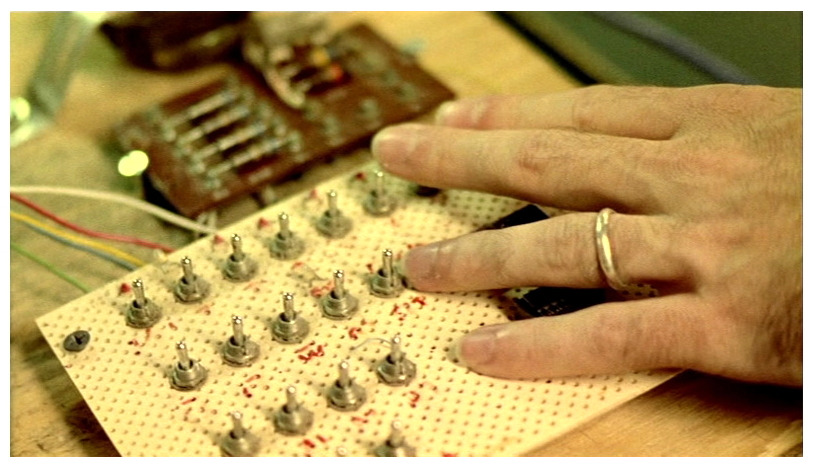 SYNOPSIS:
SYNOPSIS:
“At night and on weekends, four men in a suburban garage have built a cottage industry of error-checking devices. But they know that there is something more. There is some idea, some mechanism, some accidental side effect that is standing between them and a pure leap of innovation. And so, through trial and error they are building the device that is missing most. However, two of these men find the device and immediately realize that it is too valuable to market. The limit of their trust in each other is strained when they are faced with the question, If you always want what you can’t have, what do you want when you can have anything?” (courtesy IMDB)
REVIEW:
Traveling back in time is undeniably one of humankind’s oldest fantasies, to be able to relive a day or moment in time, to take back what one has said or done. One early story that hints at backwards time travel is Memoirs Of The 20th Century published in 1733 by Samuel Madden, which involves a series of historical reports supposedly written in 1998 and given to the narrator in 1728 by his guardian angel. The Clock That Went Backward published in 1881 by Edward Page Mitchell is considered by many to be the first story to involve not only a time machine but also a temporal paradox created by said machine, a clock that magically sends three men back in time. But is was the novel The Time Machine released in 1895 by my old smoking buddy H.G. Wells that was instrumental in moving the concept of time travel to the forefront of the public imagination.
 Of course, supernatural forms of time travel had appeared in a huge number of earlier stories from The Mahabharata to A Christmas Carol but nowadays, with advancing technology and a greater understanding of the universe, the plausibility of time travel is being explored in greater detail by authors, philosophers, physicists and filmmakers. The concept of time travel is depicted so thoroughly in Shane Carruth‘s debut feature film Primer (2004) that it seems like we’re watching people trapped in a self-inflicted experiment. Carruth presents his unusual story in a manner not unlike like a dramatised documentary. The extremely low budget (US$7000 mostly spent on film stock) actually allows Carruth to focus on his characters and their interactions, backing everything with solid physics.
Of course, supernatural forms of time travel had appeared in a huge number of earlier stories from The Mahabharata to A Christmas Carol but nowadays, with advancing technology and a greater understanding of the universe, the plausibility of time travel is being explored in greater detail by authors, philosophers, physicists and filmmakers. The concept of time travel is depicted so thoroughly in Shane Carruth‘s debut feature film Primer (2004) that it seems like we’re watching people trapped in a self-inflicted experiment. Carruth presents his unusual story in a manner not unlike like a dramatised documentary. The extremely low budget (US$7000 mostly spent on film stock) actually allows Carruth to focus on his characters and their interactions, backing everything with solid physics.
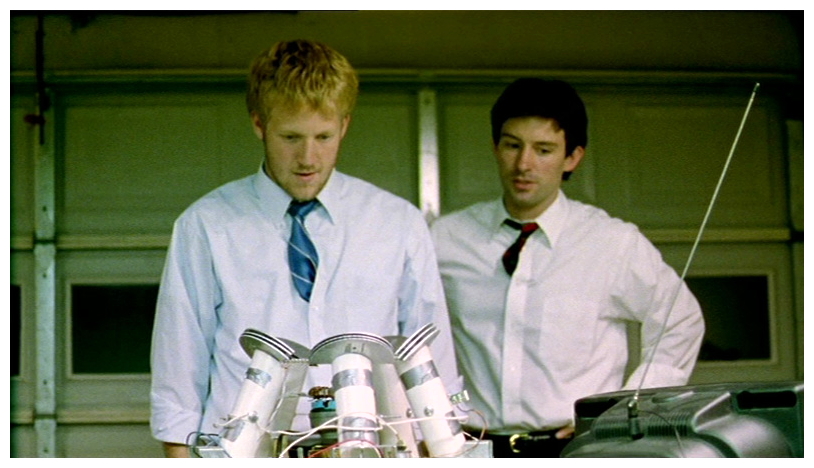 There’s a fair amount of technobabble right from the start. Abe (David Sullivan) and Aaron (Shane Carruth) are two ambitious engineers who turn out to be too smart for their own good. We are introduced to them in the middle of their everyday routine, inhabiting their own world and have their own habits and jargon. This might seem confusing to someone peeking in from the outside but, then again, this is the perfect way for the filmmaker to suck us into the story. While we’re trying to grasp what’s going on, we start to get familiar with those characters and, when the time-travel aspect finally kicks in, you’ll be tempted to rewind back to some earlier scenes, because the devil certainly is in the detail. After some testing, Abe secretly builds a prototype machine large enough to contain himself and, after using it to go back to earlier that day, demonstrates the results to Aaron by showing Abe’s past-self entering the prototype machine. Abe and Aaron build an additional machine and start using the time machines to make money in the stock market but, as their understanding of how the machines work evolves, they become more adventurous with their trips.
There’s a fair amount of technobabble right from the start. Abe (David Sullivan) and Aaron (Shane Carruth) are two ambitious engineers who turn out to be too smart for their own good. We are introduced to them in the middle of their everyday routine, inhabiting their own world and have their own habits and jargon. This might seem confusing to someone peeking in from the outside but, then again, this is the perfect way for the filmmaker to suck us into the story. While we’re trying to grasp what’s going on, we start to get familiar with those characters and, when the time-travel aspect finally kicks in, you’ll be tempted to rewind back to some earlier scenes, because the devil certainly is in the detail. After some testing, Abe secretly builds a prototype machine large enough to contain himself and, after using it to go back to earlier that day, demonstrates the results to Aaron by showing Abe’s past-self entering the prototype machine. Abe and Aaron build an additional machine and start using the time machines to make money in the stock market but, as their understanding of how the machines work evolves, they become more adventurous with their trips.
 Before becoming a filmmaker, Shane Carruth was a university math major who developed flight simulation software, and it shows. He not only wrote, directed and produced, he also composed the music and performed one of the two central roles (he was forced to cast himself as Aaron after having trouble finding actors who wouldn’t fill each line with so much drama) and the rest of the cast is mostly made up by either friends or family members. Although one of the more fantastic elements of science fiction is central to the film, Carruth’s goal was to portray scientific discovery in a down-to-earth realistic manner. After all, many of the greatest scientific breakthroughs in history have happened by accident in locations no more glamorous than Aaron’s garage: “Whether it involved the history of the number zero or the invention of the transistor, two things stood out to me. First is that the discovery that turns out to be the most valuable is usually dismissed as a side-effect. Second is that prototypes almost never include neon lights and chrome. I wanted to see a story play out that was more in line with the way real innovation takes place than I had seen on film before.”
Before becoming a filmmaker, Shane Carruth was a university math major who developed flight simulation software, and it shows. He not only wrote, directed and produced, he also composed the music and performed one of the two central roles (he was forced to cast himself as Aaron after having trouble finding actors who wouldn’t fill each line with so much drama) and the rest of the cast is mostly made up by either friends or family members. Although one of the more fantastic elements of science fiction is central to the film, Carruth’s goal was to portray scientific discovery in a down-to-earth realistic manner. After all, many of the greatest scientific breakthroughs in history have happened by accident in locations no more glamorous than Aaron’s garage: “Whether it involved the history of the number zero or the invention of the transistor, two things stood out to me. First is that the discovery that turns out to be the most valuable is usually dismissed as a side-effect. Second is that prototypes almost never include neon lights and chrome. I wanted to see a story play out that was more in line with the way real innovation takes place than I had seen on film before.”
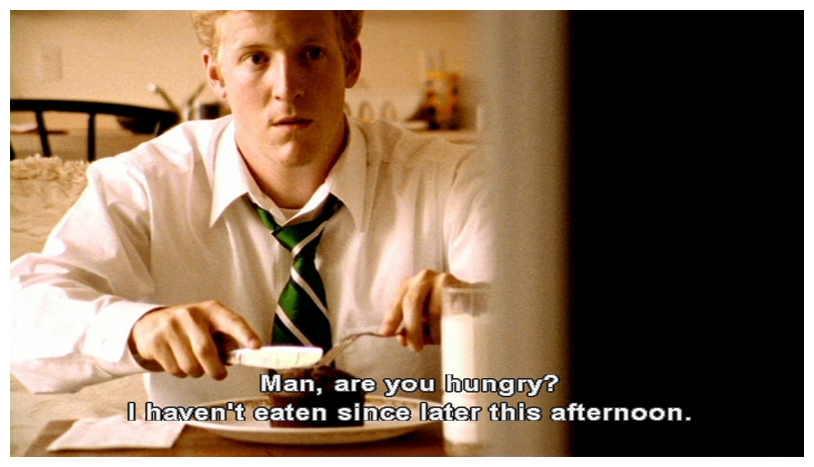 The idea of time travel has been used to various effect in science fiction cinema and literature (The Man Who Folded Himself by David Gerrold is a particular favourite) but Carruth exemplifies that its inherent dangers do not lie only in paradoxes, but also in the most complex and unpredictable variable – man himself. The central theme of the film is the breakdown of Abe and Aaron’s relationship, as a result of their inability to cope with the power afforded them by this technological advancement: “I saw these guys as scientifically accomplished but ethically, morons. They never had any reasons before to have ethical questions. So when they’re hit with this device they’re blindsided by it. The first thing they do is make money with it. They’re not talking about the ethics of altering your former self.” With a number of different time-lines, the pair also create their own doubles and you may lose count of them, but the plot’s internal logic remains intact, even if you need to see it again to comprehend it.
The idea of time travel has been used to various effect in science fiction cinema and literature (The Man Who Folded Himself by David Gerrold is a particular favourite) but Carruth exemplifies that its inherent dangers do not lie only in paradoxes, but also in the most complex and unpredictable variable – man himself. The central theme of the film is the breakdown of Abe and Aaron’s relationship, as a result of their inability to cope with the power afforded them by this technological advancement: “I saw these guys as scientifically accomplished but ethically, morons. They never had any reasons before to have ethical questions. So when they’re hit with this device they’re blindsided by it. The first thing they do is make money with it. They’re not talking about the ethics of altering your former self.” With a number of different time-lines, the pair also create their own doubles and you may lose count of them, but the plot’s internal logic remains intact, even if you need to see it again to comprehend it.
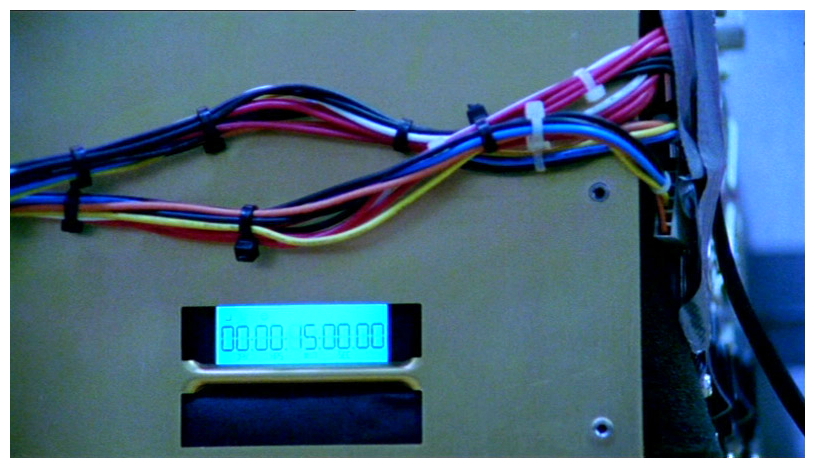 So the world of possibilities soon becomes a nightmarish maze that only gets bigger and more elaborate with every action that Abe or Aaron take. Each of them are on their own personal moebius strip looking for an exit, trying not to run into themselves. The key word here is paranoia – you can’t even trust yourself. The duo discover that you are one person today but a different one tomorrow, and they learn this the hard way. What would happen if those different versions of the same person could interact? You could literally become your own worst enemy. Steven Soderbergh, a strong supporter of independent film-making, said of Carruth’s idiosyncratic style: “I view Shane as the illegitimate offspring of David Lynch and James Cameron.” Similar in vein to the science fiction horrors of David Cronenberg, Primer definitely lacks his visceral punch but, on a cerebral level, it works overtime, functioning like a fascinating puzzle that when complete provides a rather cynical but accurate outlook on human nature.
So the world of possibilities soon becomes a nightmarish maze that only gets bigger and more elaborate with every action that Abe or Aaron take. Each of them are on their own personal moebius strip looking for an exit, trying not to run into themselves. The key word here is paranoia – you can’t even trust yourself. The duo discover that you are one person today but a different one tomorrow, and they learn this the hard way. What would happen if those different versions of the same person could interact? You could literally become your own worst enemy. Steven Soderbergh, a strong supporter of independent film-making, said of Carruth’s idiosyncratic style: “I view Shane as the illegitimate offspring of David Lynch and James Cameron.” Similar in vein to the science fiction horrors of David Cronenberg, Primer definitely lacks his visceral punch but, on a cerebral level, it works overtime, functioning like a fascinating puzzle that when complete provides a rather cynical but accurate outlook on human nature.
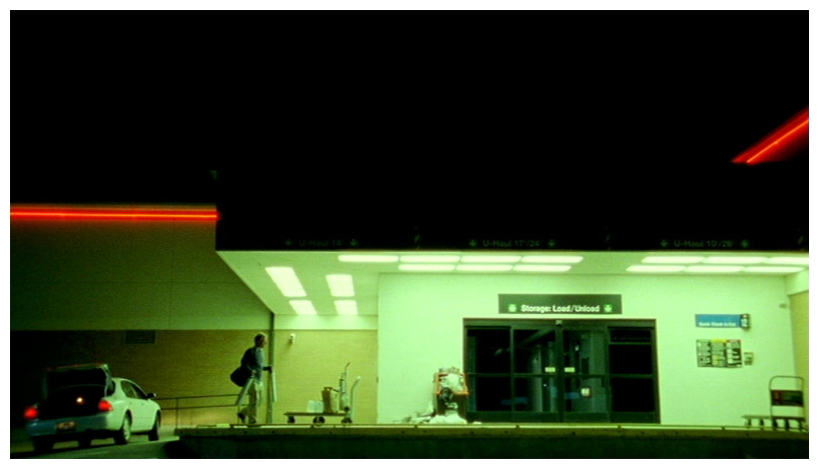 Carruth’s second film Upstream Colour (2013) was another independent auteur effort, about two people whose lives and behaviours are unknowingly affected by a complex parasite that has a three-stage life cycle in which it passes from humans to pigs to orchids. A man and woman are drawn together, entangled in the life cycle of this ageless organism, their identities become an illusion as they struggle to assemble the loose fragments of wrecked lives, but that’s another story for another time. It’s vitally important that you join me for next week’s edition of Horror News, because a man from the future told me that if you don’t read all my reviews from now on, the entire world would be devoured by an enormous mutant Star-Goat. Normally I’m highly skeptical of such claims, but he was just so certain, I feel we’d best not take the risk. So enjoy your week, and remember, the survival of the entire world depends on you. Toodles!
Carruth’s second film Upstream Colour (2013) was another independent auteur effort, about two people whose lives and behaviours are unknowingly affected by a complex parasite that has a three-stage life cycle in which it passes from humans to pigs to orchids. A man and woman are drawn together, entangled in the life cycle of this ageless organism, their identities become an illusion as they struggle to assemble the loose fragments of wrecked lives, but that’s another story for another time. It’s vitally important that you join me for next week’s edition of Horror News, because a man from the future told me that if you don’t read all my reviews from now on, the entire world would be devoured by an enormous mutant Star-Goat. Normally I’m highly skeptical of such claims, but he was just so certain, I feel we’d best not take the risk. So enjoy your week, and remember, the survival of the entire world depends on you. Toodles!
 Horror News | HNN Official Site | Horror Movies,Trailers, Reviews
Horror News | HNN Official Site | Horror Movies,Trailers, Reviews
